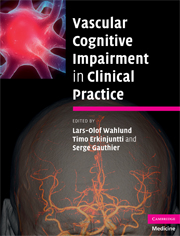Book contents
- Vascular Cognitive Impairment in Clinical Practice
- Vascular Cognitive Impairment in Clinical Practice
- Copyright page
- Contents
- Contributors
- Preface
- Section 1 Diagnosis
- Section 2 Pathophysiology
- 8 Physiopathology of large-vessel vascular dementia
- 9 Small-vessel diseases of the brain
- 10 White matter changes
- 11 Hereditary forms of cerebrovascular amyloidosis
- 12 Role of vascular risk factors in dementia
- 13 Cardiovascular disease, cognitive decline, and dementia
- 14 Vascular factors in Alzheimer’s disease
- Section 3 Treatment
- Index
14 - Vascular factors in Alzheimer’s disease
from diagnostic dichotomy to integrative etiology
from Section 2 - Pathophysiology
Published online by Cambridge University Press: 15 September 2009
- Vascular Cognitive Impairment in Clinical Practice
- Vascular Cognitive Impairment in Clinical Practice
- Copyright page
- Contents
- Contributors
- Preface
- Section 1 Diagnosis
- Section 2 Pathophysiology
- 8 Physiopathology of large-vessel vascular dementia
- 9 Small-vessel diseases of the brain
- 10 White matter changes
- 11 Hereditary forms of cerebrovascular amyloidosis
- 12 Role of vascular risk factors in dementia
- 13 Cardiovascular disease, cognitive decline, and dementia
- 14 Vascular factors in Alzheimer’s disease
- Section 3 Treatment
- Index
Summary
Keywords
- Type
- Chapter
- Information
- Vascular Cognitive Impairment in Clinical Practice , pp. 178 - 192Publisher: Cambridge University PressPrint publication year: 2009

